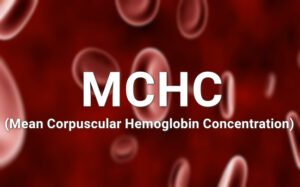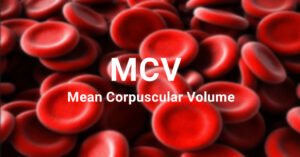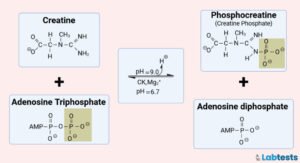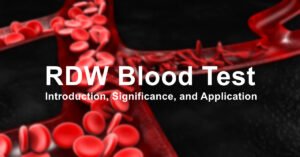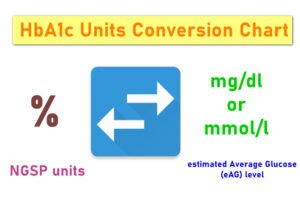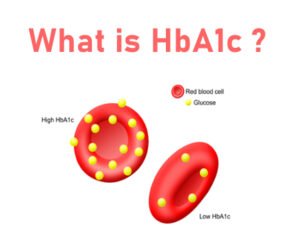MCH stands for Mean Corpuscular Hemoglobin. MCH is an average quantity of hemoglobin present in a single red blood cell (RBC). It is an inexpensive parameter essential to the standard complete blood count (CBC) test.
Since the 1980s, manual cell counting has been replaced by instrumentation. Hematological analyzers are available in the market. Most clinical laboratories use automated machines to perform standard complete blood count (CBC) tests. A routine complete blood count (CBC) test includes red cell indices as part of the profile.
Most of the automated hematological analyzers give the values of white cell count (WBCs), red cell count (RBCs), hemoglobin (Hb), hematocrit (Hct), platelet count (PLT), MCV, MCH, MCHC, and RDW.
Introduction
Red blood cells, abbreviated as RBCs, are the round, hemoglobin-carrying cells circulating in the blood. Almost 2 Million RBCs are produced by bone marrow through the normal physiological process in a second. The usual range of red blood cells (RBCs) may vary by sex, age, and geographical location.
- Newborns have a higher RBC count.
- Males have a higher RBC count as compared to females.
- People at sea level have lower RBC counts than those at high altitudes.
Mean corpuscular hemoglobin (MCH) is a valuable parameter to understand the efficacy of oxygen being distributed throughout the cells and tissues of the body. Its value is clinically significant and may vary in different health conditions. Anemia is a hematological disorder usually characterized by changes in MCH or other RBC indices. MCH is directly linked to the value of Mean corpuscular volume (MCV) and can increase or decrease in parallel to the values of MCV.
What is Hemoglobin?
Hemoglobin (Hb) is a protein molecule that carries oxygen from the lungs to the cells and tissues throughout the body. This oxygen is necessary to maintain normal physiological functioning, stay healthy, and grow.
Hemoglobin (Hb) is a giant globular protein composed of four chains; two alpha and two beta. Iron-containing heme groups are bound to four globulin chains. The red color of the blood is due to the presence of hemoglobin (Hb). Red blood cells (RBCs) carry hemoglobin. Hemoglobin is responsible for oxygen transport by the red blood cells.
Hemoglobin measurements are significant in monitoring the oxygen transport capacity of blood in a patient. Hemoglobin concentration is not altered by the changes in red blood cell size or in vitro hemolysis. Typically, hemoglobin is found in the blood, not other bodily fluids.
When should I get the MCH blood test?
The mean corpuscular hemoglobin (MCH) blood test is a standard blood test used to diagnose and monitor various medical conditions like anemias. Whenever you have signs or symptoms of anemia, you may be advised to do CBC. Carefully compare the MCH value to the other red blood cell indices that can help you to determine the cause.
When you have all or some of the following symptoms, you may be anemic
- Feeling tired all day
- Feeling irritable
- Decreased appetite
- Headache
- Numbness +/- tingling sensations in the hands and feet
- The pallor of the skin
- Shortness of breath on exertion or mild activity
- Mouth ulcers
What is the MCH blood test?
MCH blood test is the average hemoglobin (Hb) concentration per RBC, irrespective of the size of the red blood cell (RBC). MCH is an expression of the hemoglobin mass of RBCs. MCH blood tests are expressed as picograms. The mean corpuscular hemoglobin (MCH) value in blood tests usually parallels the mean corpuscular hemoglobin concentration (MCHC) value.
Reference Range of MCH blood test
- The reference range is considered a set of some values (In this case, MCH) to be expected in a population of healthy individuals.
- Each laboratory determines its reference range primarily according to the equipment and patient population. The reference range of MCH is 27 and 33 pg.
- MCH reference range is used to determine the hemoglobin in cells, which can be high or low.
- Suppose the MCH value is less than the reference range. In that case, it is called “hypochromic’.
- If the MCH value is within the reference range, then it is called “normochromic.”
- And if the value of MCH in a blood test is more than the reference range, we call it “hyperchromic.”
- It is also essential to interpret MCH value with the other red blood cell indices, which include MCV, MCHC, and RDW.
Differences between MCH and MCHC
Following are the differences between MCH and MCHC.
| Mean Corpuscular Hemoglobin (MCH) | Mean Corpuscular Hemoglobin Concentration (MCHC) |
|---|---|
| MCH measures the amount of hemoglobin (Hb) amount in one Red Blood Cell (RBC). | MCHC measures the average concentration of hemoglobin (Hb) in Red Blood Cell (RBC) volume. |
| MCH is directly affected by the value of Mean corpuscular volume (MCV). | MCHC is not affected by the value of Mean corpuscular volume (MCV). |
| The results of MCH are reported in the picogram (pg). | The results of MCHC are reported in percentages (%) or g/dL. |
| The formula to calculate the value of Mean Corpuscular Hemoglobin (MCH) isMCH = Hemoglobin (g/dL) x 10/ RBCs | The formula for measuring Mean Corpuscular Hemoglobin Concentration (MCHC) is MCHC (g/dL) =Hemoglobin (g/dL) x 100/hematocrit (Hct) % |
| The reference range of MCH is 27 and 33 pg. | The reference range of MCHC is 32-36 g/dL or 32-36 % |
| MCH is invariable once the hemoglobin synthesis is stopped during reticulocyte maturation. It is the best indicator of Hb synthesized during erythroid differentiation | MCHC has some limitations regarding sample stability and is affected by the presence of reticulocytes. |
Frequently Asked Questions
Q1. What is the formula to calculate the MCH blood test?
The formula to calculate the MCH blood test value is as follows.
MCH = Hb (g/dL) x 10/RBC (millions/microlitter)
Q2. What does it mean if your MCH is low?
If the value of MCH is less than the reference range (i.e., 27-33pg), we call it a low MCH blood test. In most cases, anemia with low MCH levels in blood tests indicates iron deficiency. Because iron is essential for hemoglobin formation in the body. The conditions most commonly associated with iron deficiency are; blood loss, pregnancy, surgery for weight loss, etc. Iron deficiency leads to low hemoglobin concentration and a drop in MCH levels.
1. Common causes of low MCH value in a blood test are
i) Reticulocytosis – Anemias due to hemolysis or blood loss (hemorrhage)
ii) Decreased hemoglobin production due to Iron deficiency
2. Uncommon causes of low MCH value in a blood test are
i) Reticulocytosis – idiopathic
ii) Decreased hemoglobin production due to possible copper or vitamin B6 (pyridoxine) deficiency
Q 3. What does it mean if your MCH is high?
If the value of MCH is more than the reference range (i.e., 27-33pg), we call it a high MCH blood test. Anemia can also be due to high MCH levels in the blood test and indicates vitamin B12 or other nutrients deficiency. Vitamin B12 is required for blood cells, DNA, and nerves.
1. Common causes of high MCH value in a blood test are:
i) Interfering substance or a test error
ii) In-vivo or in-vitro hemolysis
iii) Lipemia
2. Uncommon causes of high MCH value in a blood test are
i) Treatment with hemoglobin products (e.g., Oxyglobin)
ii) Heinz bodies
Q 4. Should I worry if my MCH is low?
If your CBC report mentions the value of MCH is less than the reference range, you should be worried.
It’s not normal, and you may have underlying medical conditions like anemias. Microcytic anemias, i.e., anemias due to iron deficiency, have a low MCV and MCH.
Some other anemias due to hemolysis or significant blood loss can also cause low MCH levels.
In some rare cases, low MCH levels can also be due to congenital problems like thalassemia, an inherited blood disorder with lower hemoglobin than normal.
Q 5. What cancers cause high MCV levels?
Mean corpuscular volume (MCV) measures the average volume of red blood cells (RBCs). MCV can be low, normal, or high in different types of anemias.
High MCV levels can be found in folate and vitamin B12 deficiency.
Now it is believed that elevated MCV level in a blood test is also linked to the incidence of several cancers.
Recent studies present an association between high MCV levels and the prognosis of colorectal, esophageal, and liver cancers.
Q 6. What are the symptoms of high MCV?
A high MCV value indicates that the size of RBCs is larger than the normal RBCs. It is usually found in macrocytic anemia, also called megaloblastic anemia, due to vitamin B12 (cobalamin) or folate deficiency. The most common symptoms of high MCV are anemia.
• Anorexia (decreased appetite)
• Diarrhea or constipation
• Glossitis
• Angular cheilosis
• Brushing
• Pallor
Q 7. What are the symptoms of low MCV?
A low MCV value indicates that the size of RBCs is smaller than the normal RBCs. It is usually found in microcytic anemia due to iron deficiency, chronic diseases, or thalassemia. The most common symptoms of low MCV are
• Pallor
• Fatigue
• Reduced exercise capacity
• Shortness of breath on exertion
• Cheilosis
• Spooning of the fingernails
References
- Seladi-Schulman, J., PhD. (2021, December 14). What Is MCH and What Do High and Low Values Mean? Healthline. Retrieved October 13, 2022, from https://www.healthline.com/health/mch
- Nagai H, Yuasa N, Takeuchi E, Miyake H, Yoshioka Y, Miyata K. The mean corpuscular volume as a prognostic factor for colorectal cancer. Surg Today 2018;48:186–194.
- Yoon HJ, Kim K, Nam YS, Yun JM, Park M. Mean corpuscular volume levels and all-cause and liver cancer mortality. Clin Chem Lab Med 2016;54:1247–1257.
- Zheng YZ, Dai SQ, Li W, et al. Prognostic value of preoperative mean corpuscular volume in esophageal squamous cell carcinoma. World J Gastroenterol 2013;19:2811–2817.

